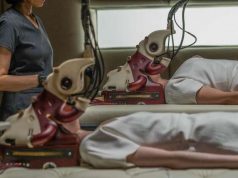Gaspar Noé, France’s Argentine-born auteur provocateur, shoots himself in the foot with “Irreversible,” a film whose pluses will be outweighed in many viewers’ minds by the distasteful minuses.
There is much to admire, especially from a structural standpoint. It is told with the scenes in reverse order, beginning with a man being beaten to death for having raped a woman, then going back to the rape, and then to the events preceding it. Ironies emerge this way that would not be apparent if the story were straightforward. Like “Memento” (2001), the other recent film told backwards, “Irreversible” features characters behaving tragically because they are unable to know, as we are, what is going to happen next.
Additionally, each scene is shot in one continuous take, with no cutting away, giving us a fly-on-the-wall perspective of the proceedings. The events seem more real and certainly more dramatic this way; it is also worth noting how difficult it is to film a story in this manner, if only for the fact that if an actor screws up, you have to start all over again.
The camera is in constant motion during the first several minutes of the film, bobbing up and down in a way that is liable to cause motion sickness in all but the most iron-gutted viewers. It is extremely disorienting, which is perfect for a film like this, though you have to wonder whether achieving a dubious goal such as making an audience sick is an admirable achievement.
And then the action begins. Already, “Irreversible” has two infamous parts, scenes that have caused scores of jaded, artsy patrons at Cannes and Sundance to walk out of the theater.
First (chronologically last) is in an S&M club, where a man’s arm is broken, followed by another man being smashed in the face repeatedly with a fire extinguisher. (Despite the setting, you may be assured neither victim finds pleasure in the violence.) Both of the attacks are accompanied by sickeningly realistic sound and visual effects; Noé was able to make it look right without cutting away by digitally inserting the appropriate blood and carnage in post-production.
Later in the film, we see a brutal rape, followed by a savage kick-in-the-face beating. The entire scene lasts about nine minutes, during which, I should remind you, there is no cutting away, no diverting of the camera’s eye. In fact, at one point, the camera swoops down and around as if to get a better look (though I’m told this was actually to prevent it being obvious that the “cement” floor is soft and padded for the sake of the actress).
The film offers much to ponder about the nature of fate, the futility of revenge and the fragility of life, and the acting throughout is spectacular. Monica Bellucci is completely fearless as Alex, the rape victim. Her boyfriend, Marcus, is Vincent Cassel, her real-life husband, his character fiercely devoted to avenging hers. His friend (and her former lover) is played with understated passion and humor by Albert Dupontel. The rapist, La Tenia (Jo Prestia), a gay pimp, is as vile as you might expect a man in his position to be.
But then there is the violence, and the sexual violence. Is it justified in being as realistic and horrific as it is? In my opinion, no. The objectives of the film could have been achieved through less graphic means — unless the objectives were to be shocking and offputting, in which case obviously it had to be done this way. I’m being facetious, but what hangs in the back of my mind is that maybe Noé’s goal really was to be controversial, and I have never been a fan of controversy just for controversy’s sake. Note his odd finale, where the screen becomes a vivid, bright strobe light for what feels like a very long period of time. OK, Noé, we get it: You’re weird. Tell your story — you’ve got a lot to say — and leave the shock tactics to the pornographers.
B- (1 hr., 39 min.; )





